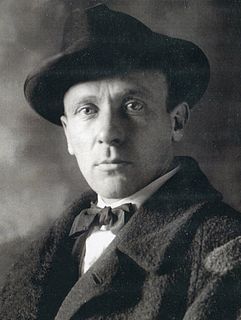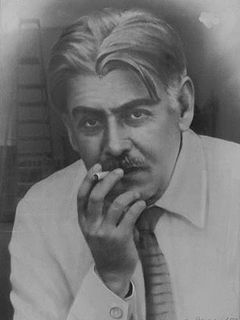
The Kamerny Theatre was a chamber theatre [1] in Moscow, founded in 1914 by director Alexander Tairov (1885–1950). Over the next 35 years, this small, intimate theater became "recognized as a major force in Russian theater". Considered among the better presentations staged at the theater were: Princess Brambilla (1920), Phèdre and Giroflé-Girofla (1922), Desire Under the Elms (1926), Day and Night (1926), The Negro (1929), The Beggars' Opera (1930) and Vishnevsky's An Optimistic Tragedy (1933). [2] Tairov's primary collaborator in building the sets was Aleksandra Ekster, and these were based upon the period's constructivist style. [3] The decor for the theatre was designed by Konstantin Medunetsky. [4]
Chamber theatre is a method of adapting literary works to the stage using a maximal amount of the work's original text and often minimal and suggestive settings.

Moscow is the capital and most populous city of Russia, with 13.2 million residents within the city limits, 17 million within the urban area and 20 million within the metropolitan area. Moscow is one of Russia's federal cities.

Alexander Yakovlevich Tairov was one of the leading innovators of theatrical art, and one of the most enduring theatre directors in Russia, and through the Soviet era.
For three decades the theater survived the effects of the Russian Revolution by remaining unpolitical, instead adopting a post-revolutionary romantic idealism [5] and relying heavily on classical material from the east and west. However, in 1928, the Kamerny put on Purple Island by Mikhail Bulgakov, which was a satire that openly mocked the government. As a result, Stalin labeled the Kamerny 'a real bourgeois theater'. Thereafter, the theater had need to reform their presentation. [6] The Soviet authorities developed a deep distrust of Tairov, calling him the last representative of the "bourgeois aestheticism". [7]

Mikhail Afanasyevich Bulgakov was a Russian writer, medical doctor and playwright active in the first half of the 20th century. He is best known for his novel The Master and Margarita, published posthumously, which has been called one of the masterpieces of the 20th century.
In 1937, the Realistic Theater was merged with the Kamerny. [8] In World War II, the theater was heavily bombed during the siege of Moscow and it did not re-open until December 25, 1943. [7] The last production staged at the Kamerny was The Seagull by Anton Chekhov in 1946. The same year the Soviet communist party "condemned all formalism and experimentation in literature and the arts". [1] The Kamerny was closed in 1949 as a result of the Zhdanov Doctrine. [8]

World War II, also known as the Second World War, was a global war that lasted from 1939 to 1945. The vast majority of the world's countries—including all the great powers—eventually formed two opposing military alliances: the Allies and the Axis. A state of total war emerged, directly involving more than 100 million people from over 30 countries. The major participants threw their entire economic, industrial, and scientific capabilities behind the war effort, blurring the distinction between civilian and military resources. World War II was the deadliest conflict in human history, marked by 50 to 85 million fatalities, most of whom were civilians in the Soviet Union and China. It included massacres, the genocide of the Holocaust, strategic bombing, premeditated death from starvation and disease, and the only use of nuclear weapons in war.

The Battle of Moscow was a military campaign that consisted of two periods of strategically significant fighting on a 600 km (370 mi) sector of the Eastern Front during World War II. It took place between October 1941 and January 1942. The Soviet defensive effort frustrated Hitler's attack on Moscow, the capital and largest city of the Soviet Union. Moscow was one of the primary military and political objectives for Axis forces in their invasion of the Soviet Union.

Anton Pavlovich Chekhov was a Russian playwright and short-story writer, who is considered to be among the greatest writers of short fiction in history. His career as a playwright produced four classics, and his best short stories are held in high esteem by writers and critics. Along with Henrik Ibsen and August Strindberg, Chekhov is often referred to as one of the three seminal figures in the birth of early modernism in the theatre. Chekhov practiced as a medical doctor throughout most of his literary career: "Medicine is my lawful wife", he once said, "and literature is my mistress."












